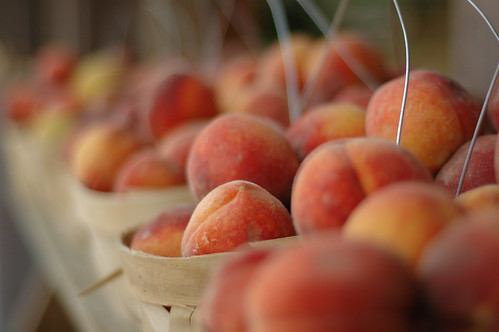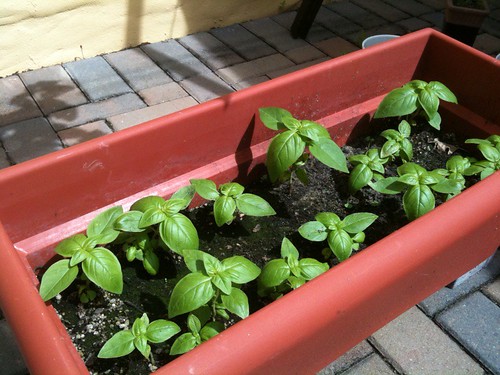A guest post from Amanda at Eat Like a Rabbit…
Recently, I saw a Twitter post suggesting that being a vegetarian is expensive. I was surprised. My family of three is vegetarian and we’ve eaten a lot of meals for $5 or less.
(Thanks, Erin, for teaching me to do a cost analysis.)
Of course it’s easy to get carried away and spend a lot on exotic vegetables. However, if you’re interested in saving money, a vegetarian meal every now and then can definitely improve your grocery store bottom line.
We are an active family, and therefore are big eaters. My 18-month-old daughter can eat a cantaloupe or two mangoes a day. I now have to cook two boxes of pasta to feed us dinner and still have enough leftover for lunch the following day.
Here are some tips for how we eat well as vegetarians on a budget.
1. Grains and Beans Are Cheap
While a “Beans and Rice Budget” is often talked about in a joking manner, those ingredients are actually quite good for you, especially if you use brown rice. Make beans and grains core to your meals, and these delicious staples will help keep you lighter and your wallet heavier.
2. Heart- and Budget-Healthy Breakfasts
Erin has already proven that soy or almond milk, even regular milk, and eggs can be purchased at a discount. But when you can’t get a good deal, consider alternative bulk grain breakfasts. For example, my husband makes oatmeal on Sunday with cinnamon, raisins, and dried apricots in it.
He efficiently makes enough to last all week. Even with premium ingredients, his breakfast costs less than $1 a day. For us, that’s much cheaper than a soy milk and boxed cereal breakfast.
3. Meat Substitutes Aren’t Always Necessary
Plant proteins are usually much cheaper than animal proteins, but this doesn’t often include meat-replacements. Vegetarian meat substitute products are fun, and many taste great. But they are often expensive. Just like with other groceries, buy MorningStar Farms and Boca products when they are on sale and with coupons. Otherwise, choose meat-free meal recipes.
4. Buy Produce on Sale
Coupons for fresh produce are rare. In season produce is generally cheaper. So, I watch the grocery store ads for what vegetables are on sale each week.
Then, I plan our meals around the fruits and vegetables on sale. I have a back-up item–like spinach from Costco–should the sales for the week not be satisfactory.
We don’t have space for a large garden, but we enjoy a container herb garden and pepper plants. The herbs and peppers require little space and little attention, but pack great free flavor into recipes.
5. Take Advantage of Your Freezer
Stock up on produce when it’s cheap and use freezer space to store fruits and vegetables, beans, and homemade bread.
I cut produce, like apples or sweet potatoes, into the shapes I might want when I cook them (diced, sliced, or shredded) and freeze them. This prolongs the life of the produce and cuts down on preparation time later. I often freeze beans when I make a batch. They can be cheaper than canned beans.
It’s also wise to stock up on good frozen vegetables. We’re partial to Pictsweet and Bird’s Eye because of the variety of vegetables they offer. Frozen vegetables are another source for healthy food when fresh vegetables aren’t available. Bagged vegetables make meal preparation fast, discouraging the temptation to eat out.
One Last Thought
Find a cookbook that fits your cooking level (beginner to pro). If it’s easy to follow, you’ll be less likely to waste your food (either by poor cooking or poor final product), especially if you’re cooking with new ingredients.
When we were first married, my cooking level was pretty minimal. Luckily, my new aunt-in-law sent me Vegetarian 5-Ingredient Gourmet. A year or so later, my husband got me Moosewood Restaurant New Classics. It still took me another year to work up to the level I felt I needed to be to cook a recipe out of it. My favorite is still Moosewood Restaurant Cooks at Home, a pescatarian cookbook.
Amanda Martin lives in Orlando, Florida with her husband and daughter. She is a Nuclear Medicine Technologist and an adjunct instructor at Florida Hospital College of Health Sciences. She blogs about for the benefit of the “vegetarian curious” at EatLikeaRabbit.net.






Kim T says
Thank you for sharing this! My oldest son and I are vegetarians and I love your recipes and ideas. Thank you for posting!
JanaC2 says
Thanks for the common sense health (and savings) tips! I appreciate the thorough information – it is very motivating! I would love a vegetarian diet (at least 3/4 of my diet is made up of fresh or frozen fruits and veggies), but I struggle with giving my kids the nutrition they need with their food allergies (nuts, soy, flax, eggs, peas, dairy, peaches, coconut, pineapple, etc.) and preferences (no beans or potatoes).
I did want to comment on the alternative “milk” issue. I have learned to make my own (rice/quinoa, hemp and coconut) at home for a significant savings. Here is a link to the easiest one (hemp milk) if you are interested [http://wp.me/p1BPh9-62].
Again, THANKS!
Natalie says
Regarding your recipe for the pineapple cucumber salsa, I have been doing a recipe like this for years, but also adding tomato and red onion and if you grill the pineapple first, it makes it even more delicious!
emily says
this post is quite a treat! for anyone who is interested in simple wholesome vegetarian dishes with an indian influence, i am posting a link for a little cook book we use (among others) at a hare krishna temple in montreal:
http://www.oocities.org/tokyo/courtyard/8761/index.html
emily